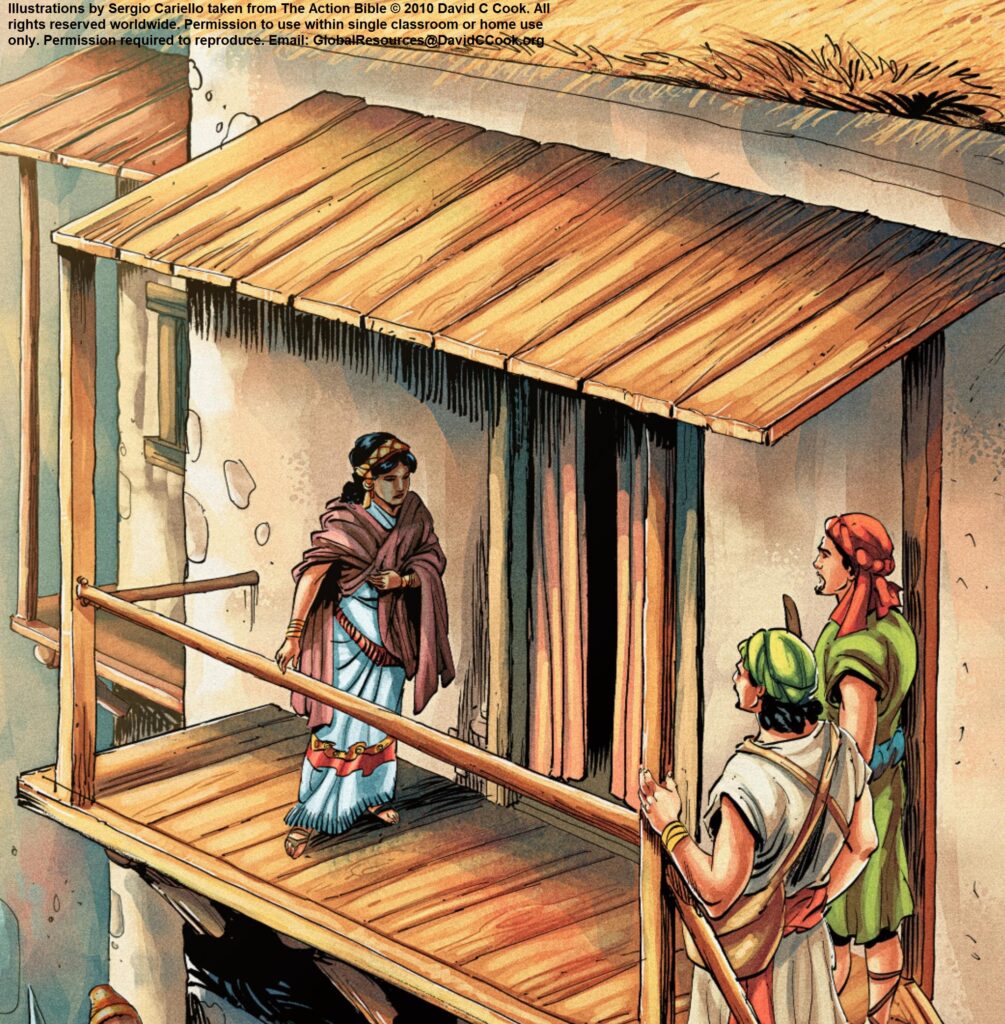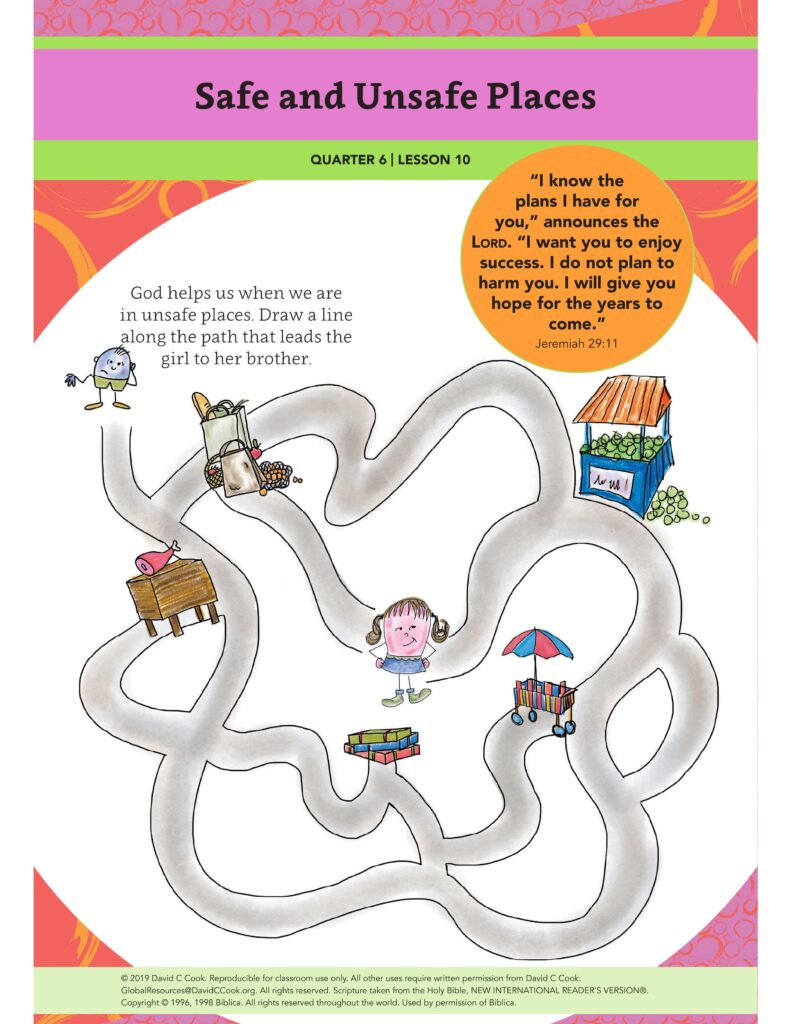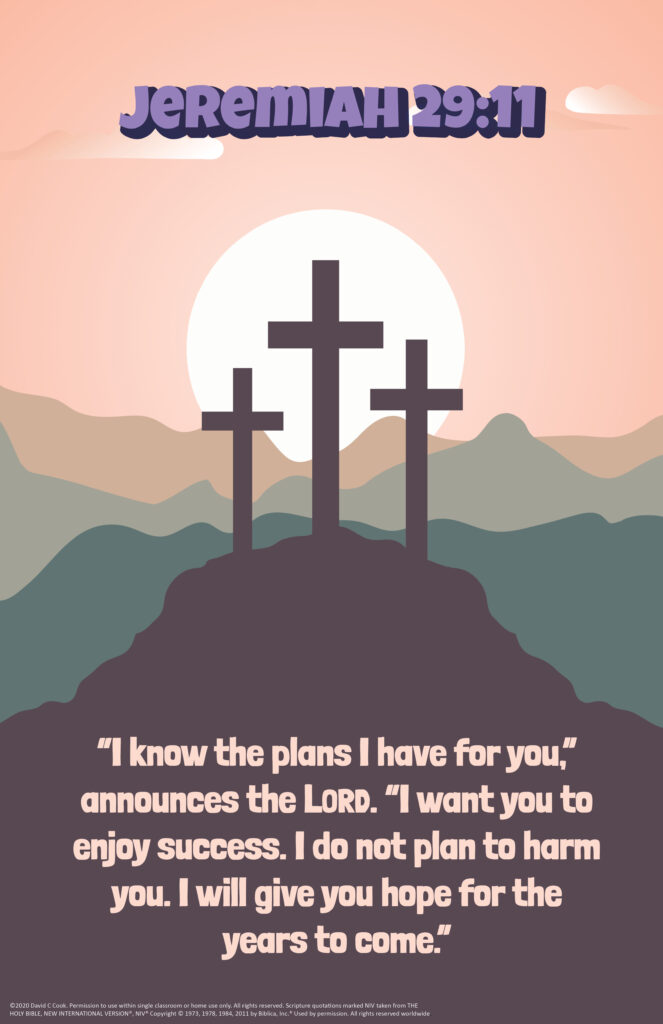During the lesson, the information for you to know is written in regular type, and what we suggest speaking or reading aloud to children is in bold. All resources for this lesson, including the Teacher Guide, Student Page, Family Connection Card, and other resources can be downloaded in a ZIP file by clicking on the following link:
In some lessons you will find "resource articles." These are articles written by experts from around the world to help equip you for your work with children and adolescents. Share them with parents or guardians if you consider it appropriate.
God is our place of safety. He gives us strength. He is always there to help us in times of trouble.
Psalm 46:1
Sometimes, no matter what we do, it is difficult to avoid unsafe places. That is why it is so important to remember that God is our place of safety. No matter where we are, we can call out to Him for help. He is always with us.
Whether you live in a place that is typically safe or a place where crime and unsafe people surround you, God is there to help you find safety. Have you ever been in a place you knew was dangerous? What did you or the people around you do to gain safety from that place? No matter what happens, know that God is with you and strengthens you. God’s love does not have borders or limitations!
Encourage families to talk about places in the community that are safe and those that are not. Ask that they help children to locate exits when they go places together and explain that knowing who and what is in a particular place can help keep children safe.
Teacher Tip: If possible, email or text the Family Connection Card to the families of your students.
Greet the children as they come to class. Ask them to sit down and look around the teaching space as they wait for class to begin.
Whether this is your first time here with us or you have been coming to class for a long time, we are going to see what you notice about our space. As you came in today, I asked you to look around the space.
What objects or people did you see as you looked around the space?
Allow 2–3 children to respond.
Now that you are familiar with what is in our space, I want all of you to close your eyes. Please do not peek.
Quickly go around to all parts of the teaching space and place 3 objects where the children can see them but may not notice them. For example, you may place a rock by the entrance to your teaching area or place a paper on the floor in a corner.
Open your eyes. I just placed 3 objects in our teaching space that were not there when you entered the space. Stay in your seats but look around to see if you can find the objects. Do not call out when you see something. Raise your hand when you see something you think was not there before.
Call on children to point out the objects that you placed around the space. Stop once all 3 objects have been found.
You found all 3 objects I placed in the teaching space! You looked around the space and remembered what was there before and what was not. This might seem like it is just a fun game, but it is actually a very important skill that can help you to be safe.
Today we will talk about how we can stay safe in different places. Just as some people are safe and some are unsafe, some places are safe while others are not. One of the ways you can tell whether you are safe in a place is by paying attention to what is around you.
You can do this by looking around a place when you first arrive there. For example, if you go to a marketplace, you could look around at all of the merchants and their stands as well as the customers to see if the space is safe. If the space is safe, the people will be speaking and acting with respect, and there will be a way to get from one stand to another without any problems.
What does a safe place look like?
Allow 2–3 children to respond.
A safe place also has exits, or places where you can come in and go out easily. Look around our space here.
If you wanted to leave our space, where could you go to get out?
Allow 2–3 children to respond. They may choose to get up and walk over to the exits if they struggle to describe where they are.
When you enter a space, it is important to look around and find where you can exit the space. This will help you to get out of the space quickly if something dangerous happens.
What are some reasons you might need to leave a space quickly?
Answers may include the following ideas or others: Because there is a fire, a storm, or a fight. There might be someone dangerous there I need to get away from. I might need to find someone I have been separated from.
Let’s play a game! When you hear me talk about a place that you think is safe, put a thumb up. If you think a place sounds unsafe, put a thumb down.
There may be little we can do to make a place safe or unsafe, but when we are aware of what is around us in a specific place, we can be ready to deal with what we see in that place.
The Bible tells the true story of a city that was unsafe. This city was called Jericho. Each time you hear me say the name of the city, Jericho, stand up and make a noise. Then, sit down. Let’s practice this.
Say, “Jericho” and stand up and make a noise. Encourage the children to do the same. Then sit down with the children. The name of the city is underlined in the story below to show you when to do the motion with the children.
Let’s listen to what happened in the city of Jericho. God had promised His people that they would live in the land of Canaan, and Jericho was their way into this land. God sent Joshua to lead His people, the Israelites, to Jericho.
Joshua sent 2 men ahead of the rest of the Israelites to see what things were like in Jericho. We could call the men spies because they were looking around and gathering information to report to the Israelites. When the spies arrived in Jericho, they went to the house of a woman called Rahab. She hid the 2 spies on the roof of her home and kept them safe from the king. The king wanted to find the spies to keep them from reporting information about Jericho to the Israelites. Rahab sent away the king’s men who came by her home to ask her about the spies. Listen to what happened next:
Read these verses directly from your Bible.
Rahab went up on the roof before the spies settled down for the night. She said to them, “I know that the Lord has given you this land. We are very much afraid of you. Everyone who lives in this country is weak with fear because of you.”
Joshua 2:8–9
What did the spies find out about the people of Jericho?
They discovered the people were scared of the Israelites.
The spies learned that the people of Jericho were afraid of them! This did not, however, make them any safer while they looked around Jericho for information to bring back to their people. Rahab knew that the 2 spies were likely to bring their people to Jericho, so she made a deal with the spies.
When the Israelites came, she would put a red rope in her window, and everyone inside her home would be safe because she helped the spies. The Bible tells us how Rahab helped the 2 spies.

Optional: If you are using The Action Bible, read pages 194–195 to the children.
The house Rahab lived in was part of the city wall. So she let the spies down by a rope through the window. She said to them, “Go up into the hills. The men chasing you won’t be able to find you. Hide yourselves there for three days until they return. Then you can go on your way.”
Joshua 2:15–16
What 2 things did Rahab do to help the spies stay safe?
She let them out an exit and she told them to hide from the men who were chasing them.
In our story, the 2 spies were in a place that was dangerous for them. The spies did exactly what Rahab told them to do, and they stayed safe! In this story, the men hid many different places to help them stay safe. When you go anywhere, there are many things you can do to help yourself stay safe. They are:
If a place becomes unsafe, it is usually best to find a way out of the unsafe place when possible. If you cannot exit an unsafe place, you could find a safe place to hide inside the place.
Let’s play a game of tag to help us practice what we learned today. For our game, most of you will be Fish. Fish have many predators. Predators are animals that chase them and eat them. I will choose 3 children to chase the rest of you. Let’s pretend these children are Crocodiles since they eat fish.
Choose 3 children to be Crocodiles. The rest of the children will be Fish. Choose 2 small areas of your teaching space where children can gather. Use these areas as “exits” for the next instruction.
Now, you may be wondering if there is a way for the Fish to stay safe from the Crocodiles. The Fish will run away from the Crocodiles and may either continue running or find an exit to run toward.
Point to the areas designated as exits for the game.
Please do not actually leave our teaching space. Instead, when you go to one of the exits for our game, sit down. These exits are safe spaces where the Crocodiles cannot go. If a Crocodile gets close to a Fish, he will gently tap the shoulder or back of a Fish to tag the Fish. If you are tagged, you must stop running and stay where you are.
Before beginning the game, ask the Fish to stand at least 2 steps away from the Crocodiles. Tell the children to begin the game. When all of the Fish are either standing still or in an exit area, end the game. You may choose to play again with different children playing Crocodiles if time allows.
When you go to a place, it is important to know where the exits are in case that place becomes unsafe. In our game, we used the exits as safe places from the Crocodiles. In real life, exits can help us to get away from dangerous people and dangerous things, such as fires.
Optional: If you are using Student Pages, give each child a crayon and allow 3–5 minutes for the children to find the path out of the maze.

God wants us to be safe. He knows each of us very well because He made us! Our memory verse today says:
God wants us to be safe. Our memory verse today says:
If you are using the Memory Verse Poster, show it to the students.
“I know the plans I have for you,” announces the Lord. “I want you to enjoy success.I do not plan to harm you. I will give you hope for the years to come.”
Jeremiah 29:11

Go through all the following motions with the memory verse once. Repeat the motions with the children 3 times.
End class by saying a blessing, based on Jeremiah 29:11, over the children.
Blessing: May you know that God wants to keep you safe. May you be careful when you enter a new place to see what is in the area around you to try to stay safe.
Lead the children in singing this quarter’s song, if possible.
Life on Life ©2020 David C Cook. Reproducible for home or classroom use only. All other uses require written permission from David C Cook [email protected]. All rights reserved.